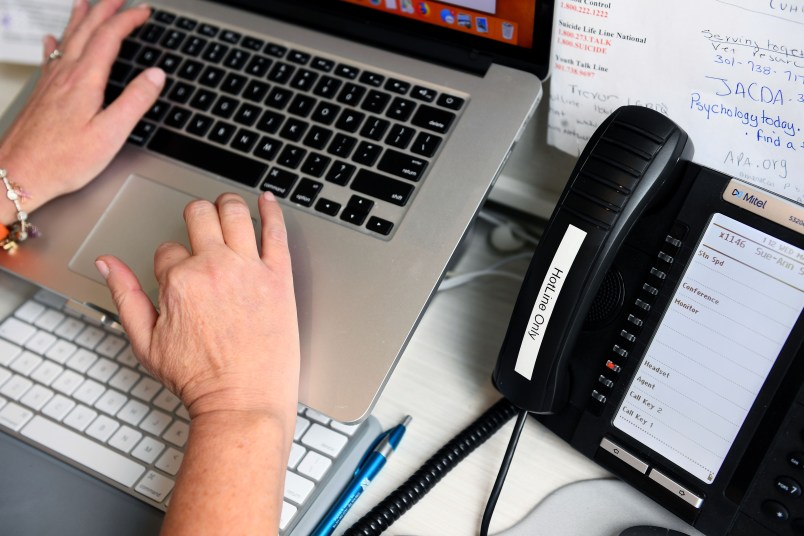Cut off from friends and family, faced with the monotony of the interior of your home, mingled only with the prospect of losing your job in a looming economic crisis as a pandemic threatens you and those you love.
That’s the reality that millions of Americans face today, and it’s taking a toll.
Crisis hotlines around the country are seeing a spike in volume associated with the spread of COVID-19, as anxious and isolated Americans call in for help.
Kathy Marchi, director of Boston’s Samaritans, which runs a crisis hotline, told TPM that her group had seen calls go from an average of 150-175 per day to a whopping average of 250.
“Our highest text number of text conversations in a month occurred in January at 964 conversations, and we thought that we would go over 1,000 by summer,” Marchi said. “We are on target now to hit over 1,000 this month.”
The increase is partly a reflection of how suicide hotlines work in the United States. The National Suicide Prevention Lifeline serves as a main national network for crisis hotlines, with its number leading to different call centers within its network.
Frances Gonzales, a spokeswoman for the National Suicide Prevention Lifeline, told TPM that separate crisis lines will have different experiences in part based on local conditions.
Marchi said that callers had gone over the past month from treating coronavirus as a background, speculative source of anxiety to a specific, negative impact on their lives.
“It’s gone from feeling like, ‘I might become more anxious and be more isolated,’ to now ‘I’m anxious because I have to save my home, I’m working on paying my bills, my routine is disrupted, I’m lonely, I don’t have access to those things that used to make me feel better,'” Marchi told TPM.
The extent to which breaking the spread of coronavirus involves prolonged isolation makes the response to the crisis particularly acute for those with severe depression, according to Julie Cerel, director of the suicide prevention and exposure lab at the University of Kentucky and a former president of the American Association of Suicidology.
“Right now we have a real example of people being isolated from others,” Cerel said, listing isolation along with a lack of belongingness, and a feeling of being a burden as primers for self-harm. “It’s that feeling that they could be a vector for disease, but in some ways that they’re more of a burden for other reasons.”
Another crisis hotline that’s seen a spike is Crisis Text Line, a non-profit that offers confidential, free emergency text-based counseling. The group also monitors the frequency of certain words and ideas in the text conversations, providing a way to mine the resource for data on what is ailing Americans.
“We’ve seen a dramatic increase in conversations round anxiety,” Bob Filbin, Crisis Text Line’s chief data scientist, told TPM. “We are seeing downstream effects of COVID like loss of income.”
One in five of people who approach Crisis Text Line mention coronavirus during the conversation, while overall volume has doubled. Since March 15, the group has seen a 60 percent increase in people reaching out.
Filbin added that he expected a “second wave” that would reflect the impact of long-term quarantine and isolation.
That, Filbin said, would likely have to do with issues focusing on “substance abuse, domestic violence, dealing with abusers at home” from whom it is more difficult to escape.
The U.S. is not alone in facing this problem.
Lulu Dong, a social scientist at the RAND Corporation, told TPM that China began to implement crisis hotlines and sent psychological response teams to Hubei province, where the outbreak originated and first reached its most intense level of contagion.
Dong said that the experience of isolation gained during quarantines instituted during the 2003 SARS outbreak made the Chinese government more aware of mental health issues that could arise from the country’s policy of mass quarantine.
But in the U.S., problems are beginning to mount with longer wait times as volumes increase.
Cerel, the University of Kentucky professor, told TPM that many hotlines were “transitioning to people working remotely, and some crisis providers are getting sick which has added to wait times.”
She added that people on the hotlines should do deep breathing or other calming exercises to manage the wait.
For Marchi, the Boston suicide hotline manager, wait times have also become an issue.
“Our system is under stress just like this is stressing every other social service or system in the country,” Marchi said. “We’re all working really hard right now to meet the demand, so we are experiencing hold times, and what I’ve been saying is that I hope that people know is that we are here for them, they are not alone.”
The National Suicide Prevention Lifeline is available at 1-800-273-8255.







In Trump country, they probably have suicide encouragement hotlines by now.
“Do it for the Dow!”
You can also contact the Crisis Text Line by texting TALK to 741741 says the American Foundation for Suicide Prevention.
How many are Trump KKKultists trying to make what Trump said sound true?
Its like a slow motion version of that scene from the Deer Hunter. Russian Roulette, courtesy of your privileged leadership.
When the nation is being governed by a death cult covered in bullshit the malaise tends to spread. Case in point, increasing numbers of TrumPublicans are declaring It is good to die for your country’s stock prices; Hume, Beck, Patrick, etc.